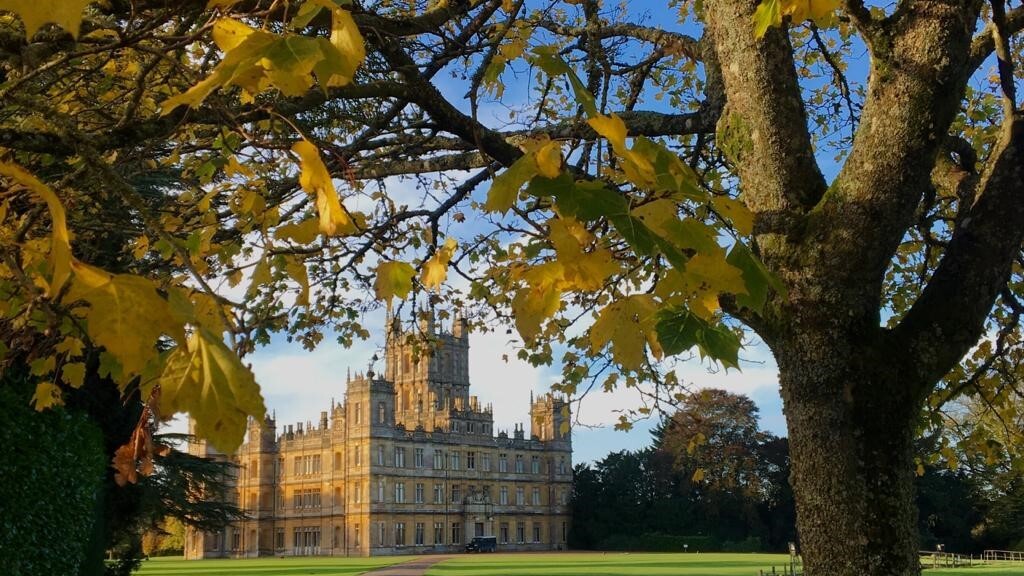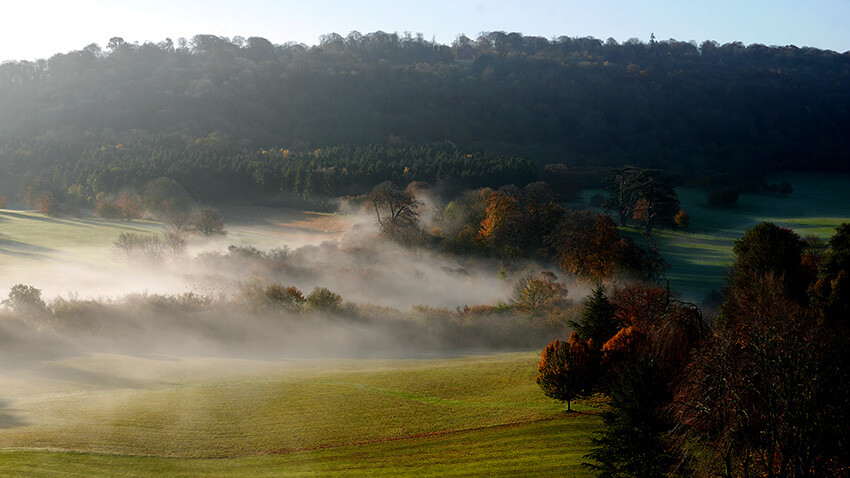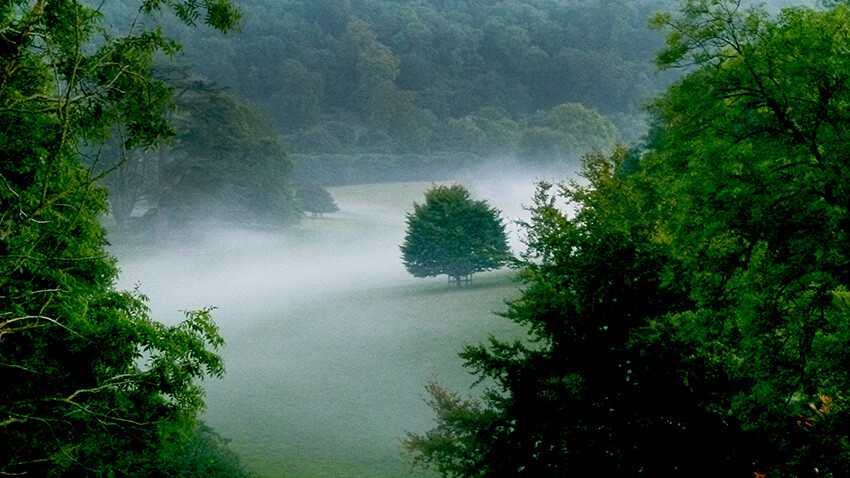Falling Leaves

Falling Leaves
 The dogs are running under and around a garden bench, round and round until one of them spies a twig instead and, picking it up, a new game of tag develops. These are the magic moments.
Bending down to pick up a leaf myself, I hold it carefully on the flat of my hand. It is starting to curl and the summer colours leaving it for the fading autumn tints, yet it is still beautiful and represents the change in the year’s seasonal journey for a tree.
The dogs are running under and around a garden bench, round and round until one of them spies a twig instead and, picking it up, a new game of tag develops. These are the magic moments.
Bending down to pick up a leaf myself, I hold it carefully on the flat of my hand. It is starting to curl and the summer colours leaving it for the fading autumn tints, yet it is still beautiful and represents the change in the year’s seasonal journey for a tree. During spring and summer, trees fill their leaves with green chlorophyll in order to generate as much energy as possible. The vivid greens of spring hearten our moods as well, they are so rich and full of water and sun. Then, as summer sun lengthens, they anticipate the freezings of winter. The trees draw the energy back from the leaf into the tree to store the sugars to tide them over the coming colder, darker season.
Thus the chlorophyll - the greenness - stops being produced and the carotenes in the leaf become more visible – they are yellow and the drier and sunnier the autumn, the more anthocyanins are produced, which are red and pink coloured, so the leaves turn even more shades of extraordinary colour.
During spring and summer, trees fill their leaves with green chlorophyll in order to generate as much energy as possible. The vivid greens of spring hearten our moods as well, they are so rich and full of water and sun. Then, as summer sun lengthens, they anticipate the freezings of winter. The trees draw the energy back from the leaf into the tree to store the sugars to tide them over the coming colder, darker season.
Thus the chlorophyll - the greenness - stops being produced and the carotenes in the leaf become more visible – they are yellow and the drier and sunnier the autumn, the more anthocyanins are produced, which are red and pink coloured, so the leaves turn even more shades of extraordinary colour.
 With cooler temperatures the layer of cells called the abscission layer which passes the sugars back into the tree comes under stress, the production of one hormone called auxin reduces which puts a strain on this abscission layer causing the bond between leaf and branch to weaken. Eventually, the strength of the join is weakened enough that the wind will blow the leaf away.
Less leaves means the tree spends less energy through the harsh winter and it is able to conserve moisture within the trunk which helps the tree remain pliable, bending in the gusts of winter winds. Less leaves also means that the wind whips through bare branches once more causing less strain on the tree.
With cooler temperatures the layer of cells called the abscission layer which passes the sugars back into the tree comes under stress, the production of one hormone called auxin reduces which puts a strain on this abscission layer causing the bond between leaf and branch to weaken. Eventually, the strength of the join is weakened enough that the wind will blow the leaf away.
Less leaves means the tree spends less energy through the harsh winter and it is able to conserve moisture within the trunk which helps the tree remain pliable, bending in the gusts of winter winds. Less leaves also means that the wind whips through bare branches once more causing less strain on the tree. Apart from the very important childish pleasure of catching falling leaves, the cycle of the trees creates essential biological support to the woodland floor activity in the soil. The leaves falling to the forest floor of an oak or beech will rot down and into the soil over the next two years and if you wish, you can collect it and let it rot down to use as an invaluable soil conditioner. It is an excellent habitat for soil life, from earthworms to beneficial bacteria as well as acting as a blanket over the soil during wintery months helping small mammals.
We have a habit of interpreting nature to bolster our own thoughts and in some ways of course autumn does teach us the beauty of letting go. It is what the trees are prepared to do in order to live.
Apart from the very important childish pleasure of catching falling leaves, the cycle of the trees creates essential biological support to the woodland floor activity in the soil. The leaves falling to the forest floor of an oak or beech will rot down and into the soil over the next two years and if you wish, you can collect it and let it rot down to use as an invaluable soil conditioner. It is an excellent habitat for soil life, from earthworms to beneficial bacteria as well as acting as a blanket over the soil during wintery months helping small mammals.
We have a habit of interpreting nature to bolster our own thoughts and in some ways of course autumn does teach us the beauty of letting go. It is what the trees are prepared to do in order to live.
 Geordie and I have planted areas of trees and shrubs with wonderful autumn colours, perhaps it is the warmth of the reds and oranges, the romance of curling up by a log fire, of a cosy oversized sweater or the smell of autumn in the air. Perhaps it is, the predictability of seasons being constant in our lives – something that can prove particularly comforting when the world and its values feel topsy turvy. Thank you to trees for all their glory:
“Go, sit upon the lofty hill, And turn your eyes around, Where waving woods and waters wild Do hymn an autumn sound.” (Elizabeth Barratt Browning)
Geordie and I have planted areas of trees and shrubs with wonderful autumn colours, perhaps it is the warmth of the reds and oranges, the romance of curling up by a log fire, of a cosy oversized sweater or the smell of autumn in the air. Perhaps it is, the predictability of seasons being constant in our lives – something that can prove particularly comforting when the world and its values feel topsy turvy. Thank you to trees for all their glory:
“Go, sit upon the lofty hill, And turn your eyes around, Where waving woods and waters wild Do hymn an autumn sound.” (Elizabeth Barratt Browning)


- Christmas
- Community
- Dogs & Horses
- Egypt & Tutankhamun
- Entertaining
- Farm
- Filming
- Gardens
- History & Heritage
- Daily Life
- Royalty
- Cooking
- Interiors
- Heroes
- Architecture
- Cars
- Conservation
- Downton Abbey
- Events
- Gardens & Landscape
- Highclere Castle Gin
- History
- Planes
- Restoration
- Stories & Books
- Uncategorized
- Visitors
- Wildlife
80 Comments
Simply Beautiful
That was beautiful thank you so much for sharing this.
The dogs are loving life.
Our summer here in New England has been extremely wet this year so I guess we are doomed to a season of brown boring color in our trees. What a sad thought. Thank you for this simple and easy to understand explanation of the changing color in the trees. I love autumn. It just might be my favorite season especially with wood burning in the fireplace, collecting apples for eating and baking, stews on the stove and the crisp fresh air. The best! Enjoy the season!
Diana Squibbb
Sitting alone in my Hungerford house and gazing out of window onto my lovely
little garden makes me yearn for similar company. Unfortunately I am dogged
by age, but within a healthy and lively body and my many friends, around the
world and here in UK, have passed away. Really appreciate your comments.
Your description of our beloved tree cycle was written so informatively and beautifully. Thank You Fiona.....and enjoy your days surrounded by cooler temps and luscious colors !!
Joan (Athens, Ga-USA)
Diana, stews on the stove sounds like a wonderful plan for the season.
Lovely the pictures of falling leaves and you and lord Carnarvon have a lovely weekend and l lovely to visit Highcelere castle and l fan of Downton Abbey
Yes, the magic of fall. Enjoyed the blog.
Dear Lady Carnarvon,
Thank you for a beautiful article on trees and nature. Autumn is my favourite season. The colour of the leaves can give us an Autumn rainbow. We need rich colours in our lives. Take care.
Susan
Simply Beautiful thank you.
Lovely the pictures of falling leave did you and lord Carnarvon have a nice weekend - fan of Downton Abbey and lovely history and lovely to highcelere castle
Lovely depiction of autumn!I love winter !!
We are just in the throes of spring here in Central Western NSW Australia with new green buds and blossoms everywhere! It is warm by day and cool in the evening. I went to see the Royal Czech Ballet Sleeping Beauty last Thursday and was very surprised at the cold night air as we stood under the moon waiting for a taxi after the show!
LadyCarnarvon your technical language to describe Autumn and the change of seasons is amazing!
And with climate change it is great to see that nature is still on time and on point! I look forward to the flowers of summer as I am sure u will look forward to icy winter snow and a warm crackling fire!
Thankyou Lady Carnarvon
Best wishes
FLEURINA
Orange City East
Central Western NSW
Australia
Thank you Fleurina, what a lovely thought that you are enjoying new green buds and blossoms.
Dear Lady C,
Your description of the science and romance of autumn is perfection. Sharing!
My Siberian Husky tries to catch falling maple leaves and can’t wait to jump into a newly raked pile of them. I can imagine how the views from your second-story windows must be now with the changing landscape. So enjoyed visiting in May!
Have a wonderful week!
What a delightful piece of writing Lady C! A fitting homage to this oh so beautiful time of year.
Lady Carnarvon,
I so enjoyed this blog, as leaves have been amazing to me since I was a child. Like you, I would gaze at a leaf in Fall with all its colors, shapes, veins, and unusual characteristics. Your writing this morning took me back to a well-scripted botany class! I especially loved the picture of the dogs sitting near the trees with the castle in the far background.
Thank you so much for another Highclere life-lesson. Hope this week is a crisp fall week for you and Lord Carnarvon and the dogs!
Martha G.
Excellent. Thank you for the time you take to pen these messages. I thoroughly enjoy them.
Dear Lady. One of my favorite times of the year. As the temperature starts to cool I get a burst of energy and the fall projects begin. In this southeastern part of the US we tend to stay indoors during the summer months to avoid the heat and humidity. But now the weather is changing and I see walks in my neighborhood and gardens to tend. Your dogs give me me motivation to enjoy the simple pleasures of life. I so enjoy your weekly blogs. Hope you and Geordie have a wonderful week ahead
Dear Lady Carnarvon,
Thank you, I very much enjoyed both your elegant scientific and poetic descriptions of the Autumnal arboreal changes at Highclere at this time of the year. Here in Queensland, we are blessed with the Spring-flowering trees that are just beginning to bloom in our gardens: the amethyst of budding Jacarandas and golden showers of Brazilian fern trees, with scarlet-flowering Poincianas soon to follow. Wherever we live, let us cherish "our true and silent friends."
Thank you Deborah and it's lovely to hear the dogs have inspired you to enjoy the outdoors.
Thank you Martha.
The season's are almost like reading your favorite book. You anticipate getting started as with spring with all the buds and blossoms of spring , then become engrossed in the body of the book as the bright green and fruits appear and mature. Then as fall arrives with it's falling leaves and harvests conclude, meloncoly sets in as you reach the finale of the book and winter sets in. Thank you for your beautiful words and photos. What a wonderful way to start a week
Greetings from Canada thanks so much for this post. We are looking forward to visiting you this Thursday. A belated milestone birthday experience. Also hoping meet your pups, too. Will be leaving our beloved dogs, Oscar and Gracie at home.
Thank you Joan, we look forward to welcoming you too.
Dear Lady Carnarvon,
Thank you for your interesting description of this lovely season. Your photos are beautiful, so inviting to imagine a long country walk or just to sit and read on the bench with a little warmth from the sun still. Your comment about letting go is quite poignant, especially as we get an older.
Trees are a beautiful reminder that it is okay to let go. Autumn has always been my favorite season.
Thank you for sharing these glorious pictures of autumn leaves. The dogs look so happy! Autumn is my favorite season. As a child, jumping into a pile of leaves was such fun! I’m looking forward to enjoying that again with my grandchildren.
Somehow you once again mirrored my thoughts when you wrote, "when the world and its values feel topsy turvy." I was feeling that especially this morning, which is an isolating feeling. It was oddly comforting to read those words from you, so many miles away and living a much different lifestyle, but yet still connected by events, seasonal and world, and perspectives and interests.
This was the sweetest blog I have ever read on a Monday morning in September. I live in Phoenix, Oregon and more than three years ago a devastating arson set fire destroyed much of the old growth here. Thank you so much for sharing this beautiful passage and peaceful, gorgeous photos.
Lucky you all to have the beauty of the beginning of Autumn Season taking place as, given climate change our weather is just a bit cool in the mornings and evenings just now and still in the 80s during the day so no leaves color change for us yet here in mid Tennessee. Such lovely photos and scientific details you've posted today, and enjoyed reading the way you and Lord Carnarvon are felt by the beauty of seasonal change. Lucky you two (and your cute dogs too).
Enjoy your Autumn Season!
Thank you again for another lovely Monday Morning Blog.
Remain well.
My Monday morning "fix" ...
We live in the middle of the woods and LOVE the different seasons. The Autumn is magical. I so enjoyed your scientific description of the leaves and of Autumn. Fascinating! It’s hard for me to imagine that there are those who don’t believe there is a God. Thank you for your blog. I always enjoy your positive words. Starts my Mondays off with a smile.
Exactly right!
Thank you, very kind Donna.
Thank you for your kind words.
Thank you, Lady Carnarvon. This blog was lovely! I want to share with my husband when we have lunch. We feel very much a part of this fall journey through the seasons here in upper East Tennessee, elevation 2400 ft. I love to watch your dogs.
Dear Lady Carnarvon,
A really nice way to start the with your lovely blog dedicated to autumn. As you say here, that the course of autumn teaches us the beauty of letting go... this is such a true phrase. Happy autumn to yourself and your loved ones.
Thank you Edith - 2,400 ft is impressive
Dear Lady Carnarvon,
I love reading your lovely post & its such a beautiful time of the year, I just love Autumn, I'm from Long Island, N.Y. & our weather is about the same as yours, so beautiful. Enjoy it with Gordie & your sweet dogs.
Thank you so much,
Barbara
P.S. we will be in Europe for our 50th Anniversary on Oct. 7th on a Viking ship from Bergen Norway to Barcelona Spain for 2 weeks, we have several ports to stop at London being one & I'm going to attempt to climb up Windsor castle. We are leaving this Friday Sept.29th & coming home Oct. 15th I feel so blessed to have made it this long to enjoy this happy time.
Lovely the pictures of falling leaves and did you and lord Carnarvon have a lovely weekend and l am fan of Downton Abbey and thank you for the email very kind of you
We are enjoying a beautiful autumn here on Vancouver Island, Canada, too. I am fulfilling a long held dream and heading to England, for the first time in 45 years, in mid October. I was disappointed to learn Highclere Castle will be closed by time I arrive. This will simply mean another trip in another year!
I live in eastern Canada, in Quebec, and each fall we are blessed with a blaze of colour. Bus tours are arranged for all the “leaf peepers” to take a trip into the surrounding countryside to see all the magnificent colours.
Everyone’s comments show how much they appreciate this beautiful season, it is a wonderful gift from a loving creator, who is the greatest artist. All praise belongs to him!
Continue to enjoy the season!
Carolyn Dear
Montreal, Quebec
I love this post. It's a perfect blend of science and romance!
I live in the Southeast United States. It has been a hot summer, but really no different than any other summer in Georgia. Fall is such a welcome relief to most of us. (There are a few souls who actually thrive in the heat and humidity. I am NOT one of them.) Fall refreshes both body and soul. You can think again. As I work in my flower field, though, I realize that the humid heat of summer, like simmering in a pot of water, now changes to an intense, drier, direct heat, until Frostmas, when the first killing frost of the season finishes the warm season annuals and my chores for the summer are done.
My favorite autumn quote comes from something I clipped out of a magazine years ago. "The air cools, leaves change color, and year after year, we travel from near and far simply to see the spectacle. Anyone who calls this a land of cynics has never watched us watching the leaves."
What a beautiful post and just what I needed to lift my spirits this Monday morning.
Dear Lady Carnarvon,
Thank you for that interesting horticultural chemistry of the tree's. Here in Texas we rarely see the full glory of all seasons. However, I always look on the tree's as one of the many astonishing creations from God and even more so as we learn the complex chemistry, it's astonishing, complex, and even more beautiful.
Also, I truly appreciate your blogs, emails, and the time out of your life to share your thoughts.
Continued blessings to you and yours.
What a lovely article and just what I needed today to remind me of simple pleasures!!! Thank you Dear Lady for posting this
If my science text books were written as eloquently I would have paid more attention.
You commented on exactly a feeling I have looking at trees. In the Spring, the green and freshness makes me feel refreshed and alive; but in the Fall those colors of the fading leaves also gives my soul joy, and nothing makes it go ahhhh more than seeing a group of leaves falling and blowing in the wind. It leaves me feeling relaxed and rested. Makes me feel like I'm a tree. LOL!
I enjoyed your interesting description of how the seasons of the trees work; some details I didn't know about. And I love learning something new every day.
Val in California
This was such a lovely read for me this morning and a perfect, cozy introduction to autumn. Thank you for sharing all of the beautiful details and facts about the changing of the trees and your daily life. I find it truly fascinating and look forward to more of this content as the season continues.
Isn't it wonderful to share in the autumn magic with others! We get quite a spectacular feast of color in the mountainous city where I live. We love to take our puppy on long walks in the crisp air and sunshine, then return home for an evening of candles, knit throws and warming stew. I love how the seasons connect us all no matter where we are on the globe.
Beautiful! Who knew all this information. Thank you. Love your weekly emails, good beginning to my week.
Thank you for this marvellous description of autumn colours in the UK; we also share this colourful festival here in Québec. Fall is my favourite season for I enjoy its fresh scents, the sun that strickes the hue of shades in the forest. Marvellous.
Joan, my name is Jenanne O'Loughlin-Cramer and when I saw your post I wondered if you are my mum's dear friend (Mary O'Loughlin)?
I’m a homeroom teacher in a classroom of 6-8 year-olds, and one of my favorite science themes to teach is Trees in the Four Seasons. Each child adopts a tree ‘friend’ on the school campus to observe and report on throughout the year. I love helping the students connect with the wonder of seasonal cycles. I expect you can guess which season is the children’s favorite for learning about trees, and mine as well… that time of year that is so lovely, so wistful, and so interesting to learn about. It’s autumn!
Best regards and greetings from northern Illinois
Laura B
P.S. My students could hold their own with you, Lady Carnarvon, if you and they were having a conversation about chlorophyll!
I love that you appreciate and value the beauty of the natural world and can equate it to all of us. Most people never see the gift.
Dearest Lady Carnarvon
I shall save this particular message from you re autumn as my birthday falls on the first day of the season ! Wonderful note thank you. I think E Browning has some competition in poetry and prose! So enjoyed this note..
Best
Laura
Have a lovely time
There are tours almost every week ...the October tours are very popular
Thank you
As I get older I wish I had studied chemistry and biology more!!!!
It is back to the reminder we all love under one sky
What a great way to learn!
It was busy - we host a park run for 10lm each year which is a bit of a thing to organise
What a fascinating piece. I so enjoy everything you write and learn something every time. I visited Highclere several years ago and would love to return to see the changes you’ve made to the landscape. And, I love the gin and so glad we can get it in the US now.❤️❤️❤️
Marvelous encouragement & such a delight to read, thank you!
Your theme reminded me of 2 of my favorite Fall quotes (unsurprisingly from a UK magazine):
"[T]he magic of this golden in-between season where endings and beginnings meet in triumph."
(https://www.countrylife.co.uk/gardens/late-summer-flowers-27061)
&
"Gardeners, more than most, enjoy travelling hopefully, with an eye to the seasons ahead."
- Alan Titchmarsh
(https://www.countrylife.co.uk)
Here in Colorado we have been granted an extra measure of our creator's artistry; a gift which (hopefully) we don't take for granted.
Dear Lady Carnarvon:
Thank you for Monday's interesting blog and sharing the very colorful pictures of Highclere Castle and the trees in and around the surrounding grounds.
I am not ready for Autumn/Fall, even though I do enjoy the change in weather and the trees!
The leaves on the trees in my area are slowly beginning to change. Watching this change, takes me back to my childhood, when my parents would take us to Hines Park to gather the largest and most attractive leaves. Once gathered, we would return home to identify, label, mount, and coat the leaves with shellac. Once dried, these mountings were put on display until the following Autumn.
So, until next week, Happy Autumn to you.
Perpetua Crawford
Thank you - very happy you like the gin!
I don't have as many trees as you, I'm sure, but I'd love to know how the castle staff handle the fallen leaves that are in your open area.
Beautiful thank you for sharing. The dogs have their best lives. I love the colours of Autumn
As always.. your words make me smile. In this topsy turvy world... thank you for your words.
I live in the USA in the state of Michigan. Autumn is my favorite month here, with the cooler temperatures and the abundance of color the trees provide. We have had an unusually long and warm summer, and are lacking in rain. I'm wondering how the leaves will fare this season?
Autumn has always been my favorite time of year, even here in the deep south of the United States. Our leaves have begun falling, and a few of them have beautiful colours. Today the temperatures almost feel autumnal, at 21 degrees...well for us! Frost is still a couple of months away!
Such beautiful trees there! We also enjoy our lovely fall trees in the Rocky Mountains here in Colorado.
You paint the most beautiful picture with words,it warms the heart like a great big hug,so much gratitude for all you do!
What a lovely thing to read at the beginning of my favorite season. Thank you for the great summary of the science behind the leaves changing. I have a soon-to-be-4-year-old daughter who has started asking questions about subjects exactly like this, to which I don’t usually have a perfect ready-to-go answer. So I will definitely be using your explanation for this particular question! Wishing you a lovely week!
Simply beautiful
Hoping to visit next year on our trip to London!
Reading what you have to say is a beautiful way to start the week as always !
When you want to curl up with a good book try
THE OVERSTORY by Richard Powers. It's amazing how trees communicate
Carol
North Carolina
Very unique and refreshing way to think about circle of life




So very interesting ,thank you .doggies look very happy !!